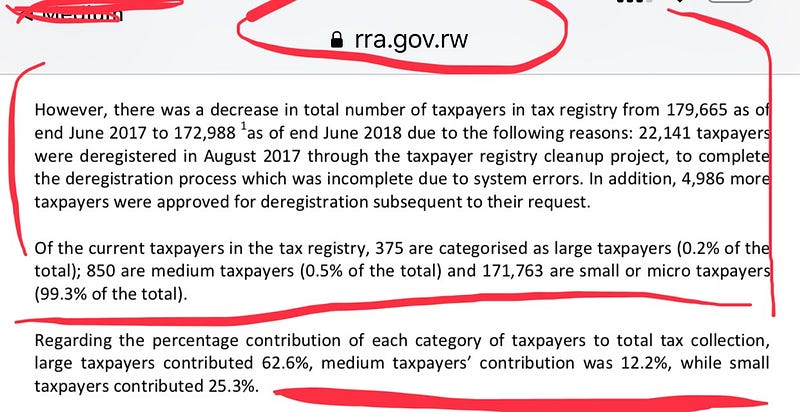By David Himbara
Kagame’s central government expenditure is financed by foreign aid to the tune of 70.9%. Rwanda is among the top three most aid-dependent countries in the world and the topmost aid-recipient state in East Africa. Kagame’s 2016 call for deadline to end aid addiction was empty rhetoric.
SUMMARY: What do we learn from the most recent Annual Activity Report of Rwanda Revenue Authority (RRA), namely, the 2017/2018 Report? Is the ability of Rwandans to pay taxes improving so as to achieve General Paul Kagame’s stated goal of ending the reliance on outsiders for basic sustenance? The taxpayer data in 2017/2018 RRA’s Annual Activity Report demonstrates that Rwanda’s prospects for lessening let alone ending aid-dependence are dismal. Kagame’s ill-conceived closure of the common border with Uganda, and by extension, Kenya, will undoubtedly sabotage Rwanda’s already wretched taxpayer base.
In 2016, Kagame called for a deadline to end Rwanda’s reliance “on others”.
In his “state of the Nation Address” of 2016, Kagame called for a deadline for restoring Rwanda’s dignity by ending the practice of “relying on others.” As Kagame put it:
”It is better to face things the hard way and go straight to the heart of any problem. An example, is something we have been talking about for a long time, the issue of relying on others to pay for things that benefit us. It is really a question of dignity, our agaciro. Therefore, among the decisions of this Umushyikirano, we should resolve to set a deadline, which should come sooner rather than later, after which Rwanda will no longer be waiting for what others hand out to us.”
This was a tall order. Rwanda is one of the top three most aid-dependent countries in the world, and the topmost aid-dependent state in the East African Community (EAC). Two World Bank indicators demonstrate this — foreign aid per capita and the percentage of foreign aid in the central government’s expenditure.
In the case of foreign aid per capita, Rwanda’s aid per capita is US$100 against Burundi at US$39; Kenya, US$50; Tanzania, US$45; and Uganda with an aid per capita of US$47. Foreign aid as a percentage of central government expenditure in Rwanda stands at 70.9%. There are only two countries in the world with a higher percentage of donor support to central government expenditure than Rwanda. These are Malawi at 127.9% and Micronesia at 120.6%.
Is Rwanda’s domestic capacity to generate revenue improving? Is the number of taxpayers increasing?

According to the 2017–2018 RRA’s Annual Activity Report, the number of taxpayers in Rwanda is 172,988 as of June 2018. RRA describes Rwandan taxpayers as follows:
”There was a decrease in total number of taxpayers in tax registry from 179,665 as of end June 2017 to 172,988 as of end June 2018…Of the current taxpayers in the tax registry, 375 are categorised as large taxpayers (0.2% of the total); 850 are medium taxpayers (0.5% of the total) and 171,763 are small or micro taxpayers (99.3% of the total). Regarding the percentage contribution of each category of taxpayers to total tax collection, large taxpayers contributed 62.6%, medium taxpayers’ contribution was 12.2%, while small taxpayers contributed 25.3%.”
In other words, the number of taxpayers in Rwanda decreased by 6,677 between 2017 and 2018. There is an even bigger problem than the drop in the number of taxpayers. That is the existing taxpayers’ ability to pay taxes which, naturally, are the means of ending the dependence on foreign aid.
Rwandan taxpayers’ ability to pay taxes is dismal.
As indicated by RRA’s data, of Rwanda’s 172,988 taxpayers, 171,763 or 99.3% are small and micro taxpayers. These are defined as entities having an annual turnover equal to or less than RWF 20 million (US$22,159). Put in another way, the number of taxpayers with an annual gross revenue of over US$22,159 is only 1,225 (0.7% of total taxpayers) comprising 375 ”large taxpayers” and 850 ”medium taxpayers.” The term “pitiful” describes both the profiles and capabilities of Rwandan taxpayers.
Kagame’s rhetoric on ending Rwanda’s dependence on foreign aid is just that — empty rhetoric.
Kagame’s Rwanda is Banana Republic per excellence. Rwandan taxpayers are mostly small and micro businesses. Shockingly, of 172,988 Rwandan taxpayers, only 1,225 or 0.7% have more than US$22,159 in annual gross revenue. Little wonder then that 70.9% of Kagame’s central government expenditure comes from foreign donations. Rwanda’s high foreign aid dependence is further illustrated by aid per capita. In comparison to its neighbours, Rwanda’s foreign aid per capita of US$100 more than doubles Burundi’s, and doubles that of Uganda. Kagame’s rhetoric of ending Rwanda’s dependence on foreign aid is just that – empty rhetoric. This gentleman has since February 27, 2019, closed the international that connects Rwanda to Uganda and to the Kenyan seaport of Mombasa via which a significant amount of Rwandan international trade is conducted. Preliminary reportsindicate taxpayers in the transport sector that used to transport people on the Rwanda-Uganda-Kenya corridor have been decimated by this self-inflicted injury.






























































